Australian Law: Employee, Contractor, and Discrimination Analysis
VerifiedAdded on 2022/08/18
|8
|1651
|12
Homework Assignment
AI Summary
This assignment delves into key aspects of Australian law relevant to the hospitality industry, specifically addressing the distinctions between employees and independent contractors. It examines the concept of vicarious liability, assessing when a business, like the Abacus Hotel, can be held responsible for the actions of its workers, particularly in cases of negligence leading to guest injuries. The assignment further analyzes discrimination in the workplace, focusing on disability discrimination under Australian law, using a case involving Sheridan Hotel and Yeung. The analysis uses relevant case law, such as Zuijs vs. Wirth Bros, Hollis vs. Vabu Pty Ltd, Quinlan vs. B&Q, and Howden vs. Capital Copiers (Edinburgh) Ltd, to support its arguments. The assignment concludes that the Abacus Hotel is not liable for the actions of the independent contractor, and that Yeung can claim compensation from Sheridan Hotel on the grounds of disability discrimination.

Running head: AUSTRALIAN LAW
AUSTRALIAN LAW
Name of the Student
Name of the University
Authors Note
AUSTRALIAN LAW
Name of the Student
Name of the University
Authors Note
Paraphrase This Document
Need a fresh take? Get an instant paraphrase of this document with our AI Paraphraser
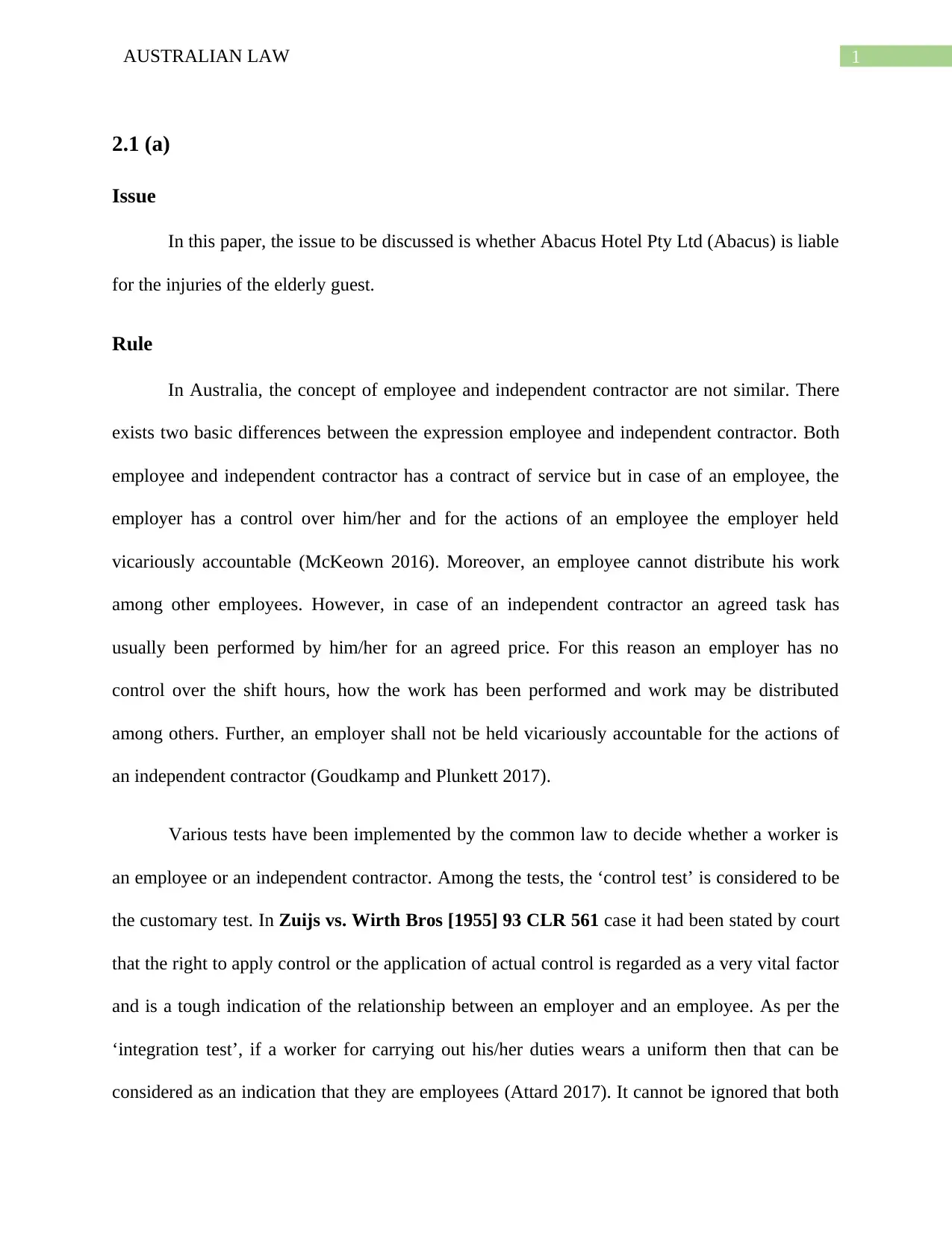
1AUSTRALIAN LAW
2.1 (a)
Issue
In this paper, the issue to be discussed is whether Abacus Hotel Pty Ltd (Abacus) is liable
for the injuries of the elderly guest.
Rule
In Australia, the concept of employee and independent contractor are not similar. There
exists two basic differences between the expression employee and independent contractor. Both
employee and independent contractor has a contract of service but in case of an employee, the
employer has a control over him/her and for the actions of an employee the employer held
vicariously accountable (McKeown 2016). Moreover, an employee cannot distribute his work
among other employees. However, in case of an independent contractor an agreed task has
usually been performed by him/her for an agreed price. For this reason an employer has no
control over the shift hours, how the work has been performed and work may be distributed
among others. Further, an employer shall not be held vicariously accountable for the actions of
an independent contractor (Goudkamp and Plunkett 2017).
Various tests have been implemented by the common law to decide whether a worker is
an employee or an independent contractor. Among the tests, the ‘control test’ is considered to be
the customary test. In Zuijs vs. Wirth Bros [1955] 93 CLR 561 case it had been stated by court
that the right to apply control or the application of actual control is regarded as a very vital factor
and is a tough indication of the relationship between an employer and an employee. As per the
‘integration test’, if a worker for carrying out his/her duties wears a uniform then that can be
considered as an indication that they are employees (Attard 2017). It cannot be ignored that both
2.1 (a)
Issue
In this paper, the issue to be discussed is whether Abacus Hotel Pty Ltd (Abacus) is liable
for the injuries of the elderly guest.
Rule
In Australia, the concept of employee and independent contractor are not similar. There
exists two basic differences between the expression employee and independent contractor. Both
employee and independent contractor has a contract of service but in case of an employee, the
employer has a control over him/her and for the actions of an employee the employer held
vicariously accountable (McKeown 2016). Moreover, an employee cannot distribute his work
among other employees. However, in case of an independent contractor an agreed task has
usually been performed by him/her for an agreed price. For this reason an employer has no
control over the shift hours, how the work has been performed and work may be distributed
among others. Further, an employer shall not be held vicariously accountable for the actions of
an independent contractor (Goudkamp and Plunkett 2017).
Various tests have been implemented by the common law to decide whether a worker is
an employee or an independent contractor. Among the tests, the ‘control test’ is considered to be
the customary test. In Zuijs vs. Wirth Bros [1955] 93 CLR 561 case it had been stated by court
that the right to apply control or the application of actual control is regarded as a very vital factor
and is a tough indication of the relationship between an employer and an employee. As per the
‘integration test’, if a worker for carrying out his/her duties wears a uniform then that can be
considered as an indication that they are employees (Attard 2017). It cannot be ignored that both
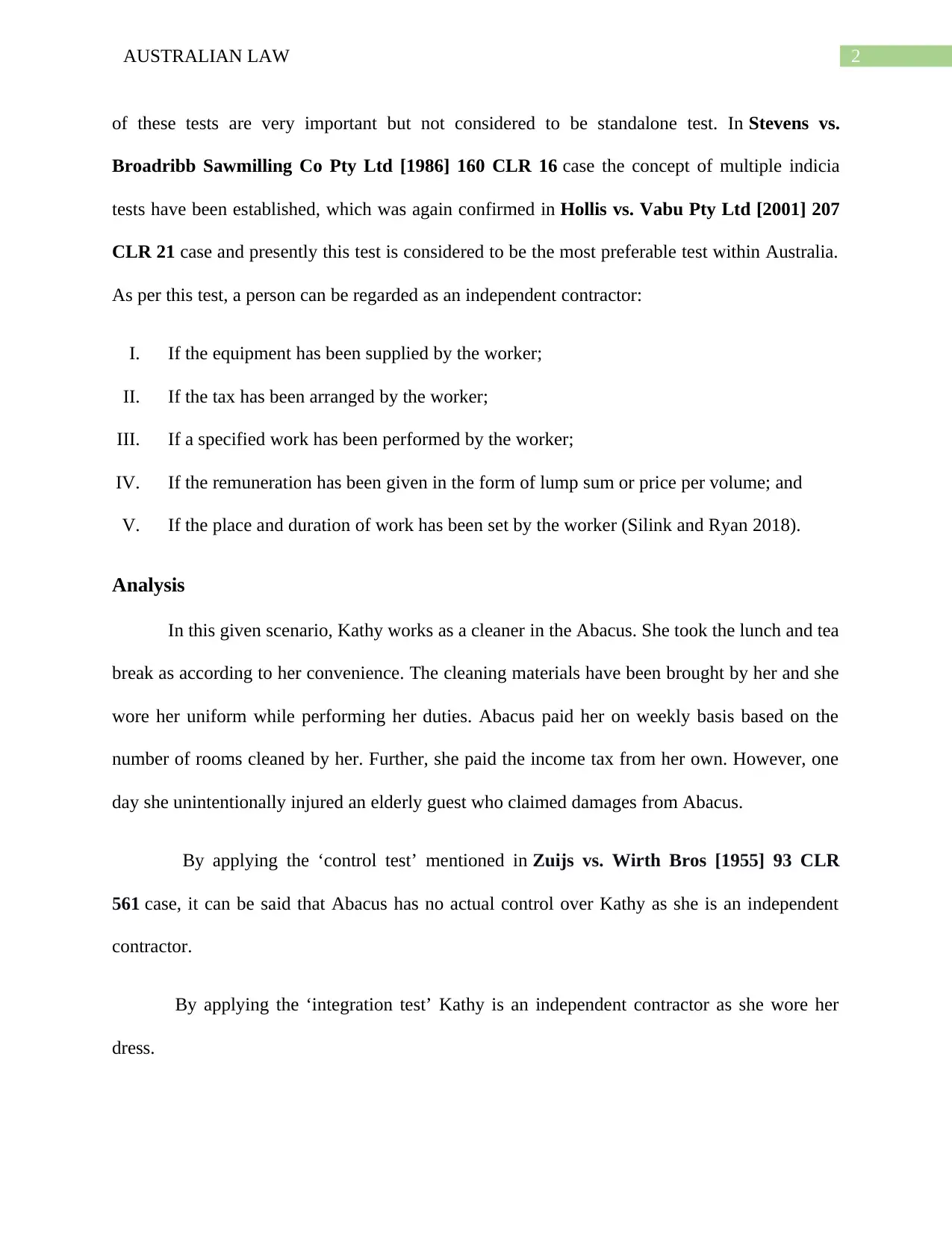
2AUSTRALIAN LAW
of these tests are very important but not considered to be standalone test. In Stevens vs.
Broadribb Sawmilling Co Pty Ltd [1986] 160 CLR 16 case the concept of multiple indicia
tests have been established, which was again confirmed in Hollis vs. Vabu Pty Ltd [2001] 207
CLR 21 case and presently this test is considered to be the most preferable test within Australia.
As per this test, a person can be regarded as an independent contractor:
I. If the equipment has been supplied by the worker;
II. If the tax has been arranged by the worker;
III. If a specified work has been performed by the worker;
IV. If the remuneration has been given in the form of lump sum or price per volume; and
V. If the place and duration of work has been set by the worker (Silink and Ryan 2018).
Analysis
In this given scenario, Kathy works as a cleaner in the Abacus. She took the lunch and tea
break as according to her convenience. The cleaning materials have been brought by her and she
wore her uniform while performing her duties. Abacus paid her on weekly basis based on the
number of rooms cleaned by her. Further, she paid the income tax from her own. However, one
day she unintentionally injured an elderly guest who claimed damages from Abacus.
By applying the ‘control test’ mentioned in Zuijs vs. Wirth Bros [1955] 93 CLR
561 case, it can be said that Abacus has no actual control over Kathy as she is an independent
contractor.
By applying the ‘integration test’ Kathy is an independent contractor as she wore her
dress.
of these tests are very important but not considered to be standalone test. In Stevens vs.
Broadribb Sawmilling Co Pty Ltd [1986] 160 CLR 16 case the concept of multiple indicia
tests have been established, which was again confirmed in Hollis vs. Vabu Pty Ltd [2001] 207
CLR 21 case and presently this test is considered to be the most preferable test within Australia.
As per this test, a person can be regarded as an independent contractor:
I. If the equipment has been supplied by the worker;
II. If the tax has been arranged by the worker;
III. If a specified work has been performed by the worker;
IV. If the remuneration has been given in the form of lump sum or price per volume; and
V. If the place and duration of work has been set by the worker (Silink and Ryan 2018).
Analysis
In this given scenario, Kathy works as a cleaner in the Abacus. She took the lunch and tea
break as according to her convenience. The cleaning materials have been brought by her and she
wore her uniform while performing her duties. Abacus paid her on weekly basis based on the
number of rooms cleaned by her. Further, she paid the income tax from her own. However, one
day she unintentionally injured an elderly guest who claimed damages from Abacus.
By applying the ‘control test’ mentioned in Zuijs vs. Wirth Bros [1955] 93 CLR
561 case, it can be said that Abacus has no actual control over Kathy as she is an independent
contractor.
By applying the ‘integration test’ Kathy is an independent contractor as she wore her
dress.
⊘ This is a preview!⊘
Do you want full access?
Subscribe today to unlock all pages.

Trusted by 1+ million students worldwide
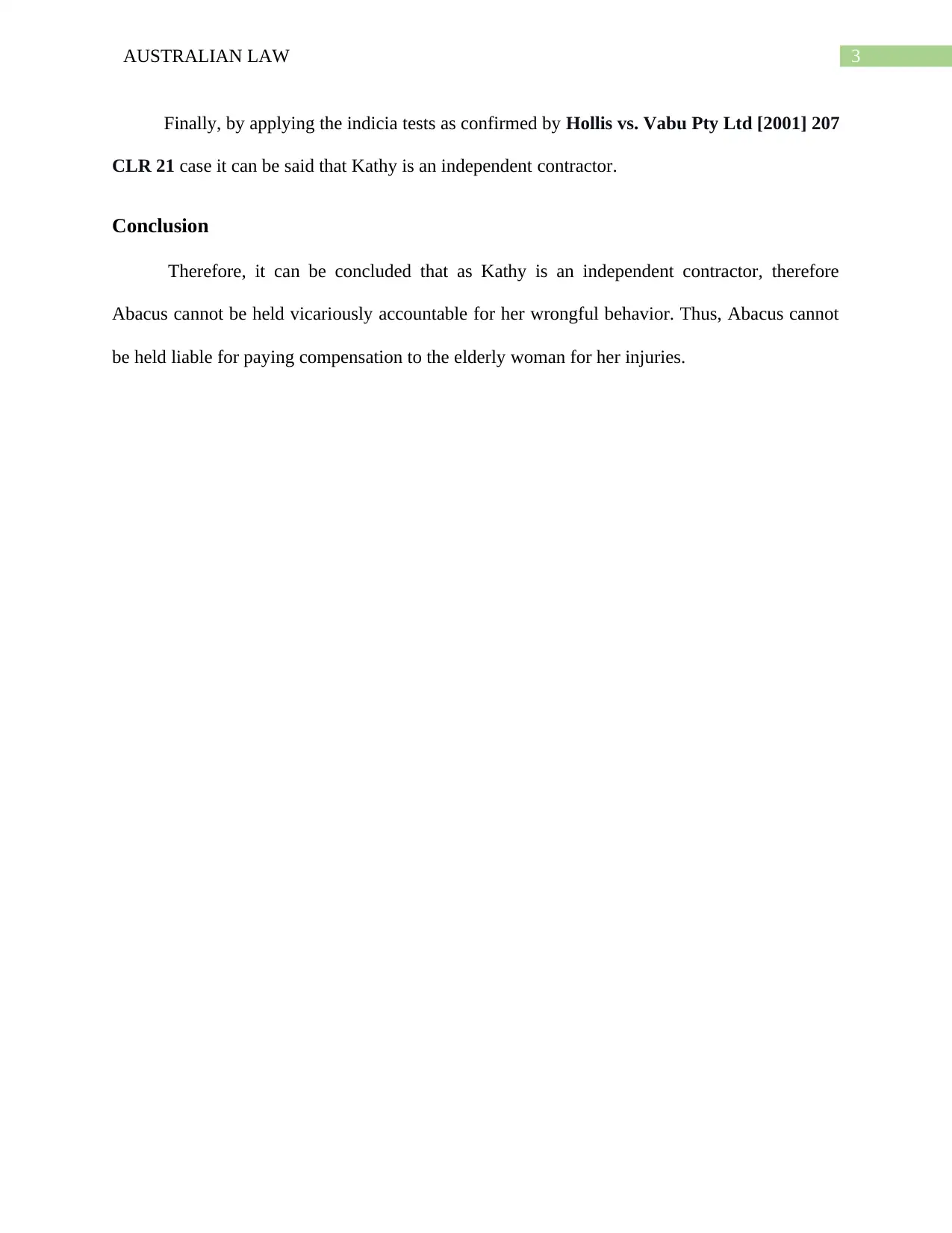
3AUSTRALIAN LAW
Finally, by applying the indicia tests as confirmed by Hollis vs. Vabu Pty Ltd [2001] 207
CLR 21 case it can be said that Kathy is an independent contractor.
Conclusion
Therefore, it can be concluded that as Kathy is an independent contractor, therefore
Abacus cannot be held vicariously accountable for her wrongful behavior. Thus, Abacus cannot
be held liable for paying compensation to the elderly woman for her injuries.
Finally, by applying the indicia tests as confirmed by Hollis vs. Vabu Pty Ltd [2001] 207
CLR 21 case it can be said that Kathy is an independent contractor.
Conclusion
Therefore, it can be concluded that as Kathy is an independent contractor, therefore
Abacus cannot be held vicariously accountable for her wrongful behavior. Thus, Abacus cannot
be held liable for paying compensation to the elderly woman for her injuries.
Paraphrase This Document
Need a fresh take? Get an instant paraphrase of this document with our AI Paraphraser

4AUSTRALIAN LAW
Reference
Attard, C., 2017. Australia's Franchisors Face Increased Liability for Protecting a Franchisee's
Vulnerable Workers. Int'l J. Franchising L., 15, p.7.
Goudkamp, J. and Plunkett, J., 2017. Vicarious liability in Australia: on the move?. Oxford
University Commonwealth Law Journal, 17(1), pp.162-170.
McKeown, T., 2016. A consilience framework: Revealing hidden features of the independent
contractor. Journal of Management & Organization, 22(6), pp.779-796.
Silink, A. and Ryan, D., 2018. VICARIOUS LIABILITY FOR INDEPENDENT
CONTRACTORS. The Cambridge Law Journal, 77(3), pp.458-461.
Reference
Attard, C., 2017. Australia's Franchisors Face Increased Liability for Protecting a Franchisee's
Vulnerable Workers. Int'l J. Franchising L., 15, p.7.
Goudkamp, J. and Plunkett, J., 2017. Vicarious liability in Australia: on the move?. Oxford
University Commonwealth Law Journal, 17(1), pp.162-170.
McKeown, T., 2016. A consilience framework: Revealing hidden features of the independent
contractor. Journal of Management & Organization, 22(6), pp.779-796.
Silink, A. and Ryan, D., 2018. VICARIOUS LIABILITY FOR INDEPENDENT
CONTRACTORS. The Cambridge Law Journal, 77(3), pp.458-461.
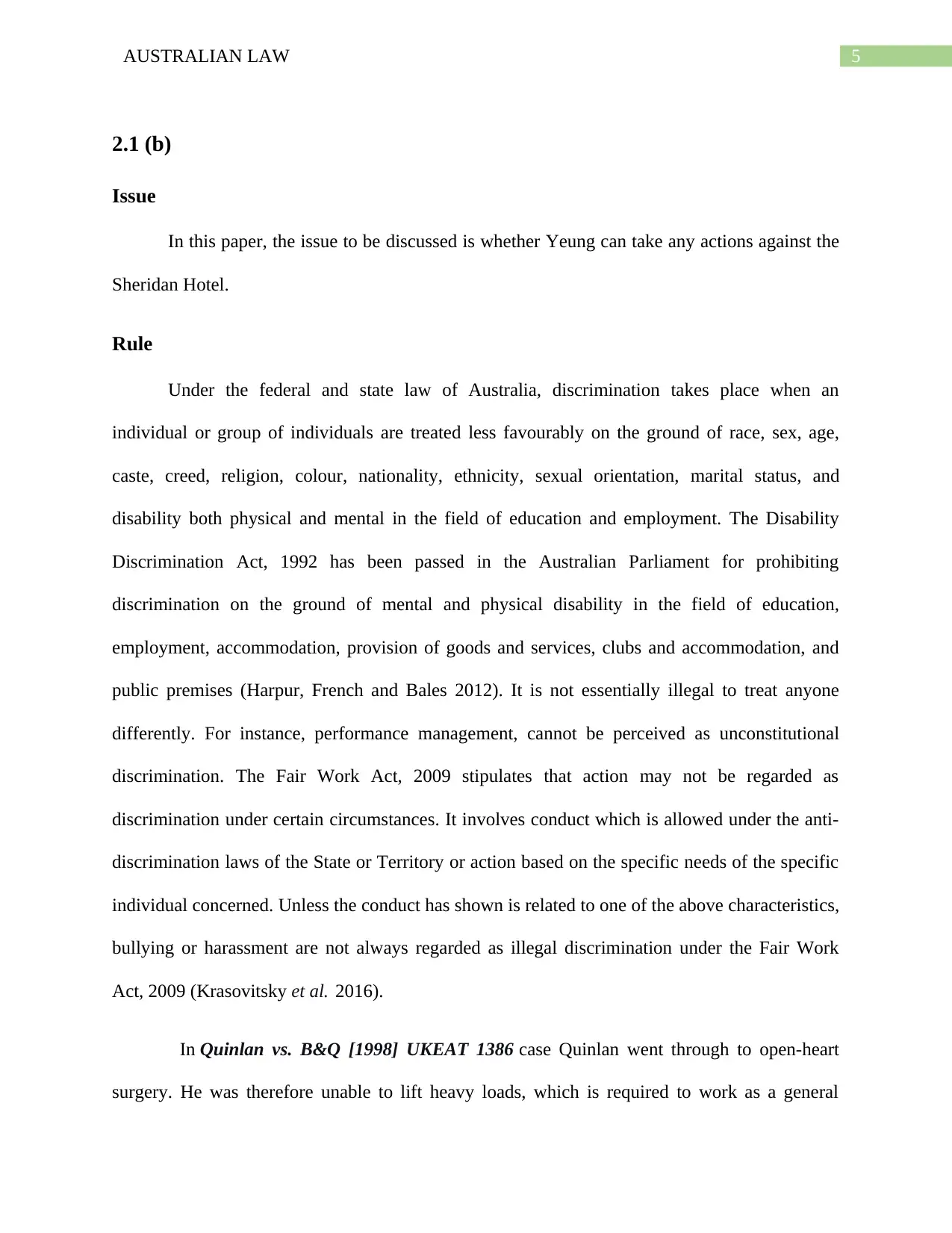
5AUSTRALIAN LAW
2.1 (b)
Issue
In this paper, the issue to be discussed is whether Yeung can take any actions against the
Sheridan Hotel.
Rule
Under the federal and state law of Australia, discrimination takes place when an
individual or group of individuals are treated less favourably on the ground of race, sex, age,
caste, creed, religion, colour, nationality, ethnicity, sexual orientation, marital status, and
disability both physical and mental in the field of education and employment. The Disability
Discrimination Act, 1992 has been passed in the Australian Parliament for prohibiting
discrimination on the ground of mental and physical disability in the field of education,
employment, accommodation, provision of goods and services, clubs and accommodation, and
public premises (Harpur, French and Bales 2012). It is not essentially illegal to treat anyone
differently. For instance, performance management, cannot be perceived as unconstitutional
discrimination. The Fair Work Act, 2009 stipulates that action may not be regarded as
discrimination under certain circumstances. It involves conduct which is allowed under the anti-
discrimination laws of the State or Territory or action based on the specific needs of the specific
individual concerned. Unless the conduct has shown is related to one of the above characteristics,
bullying or harassment are not always regarded as illegal discrimination under the Fair Work
Act, 2009 (Krasovitsky et al. 2016).
In Quinlan vs. B&Q [1998] UKEAT 1386 case Quinlan went through to open-heart
surgery. He was therefore unable to lift heavy loads, which is required to work as a general
2.1 (b)
Issue
In this paper, the issue to be discussed is whether Yeung can take any actions against the
Sheridan Hotel.
Rule
Under the federal and state law of Australia, discrimination takes place when an
individual or group of individuals are treated less favourably on the ground of race, sex, age,
caste, creed, religion, colour, nationality, ethnicity, sexual orientation, marital status, and
disability both physical and mental in the field of education and employment. The Disability
Discrimination Act, 1992 has been passed in the Australian Parliament for prohibiting
discrimination on the ground of mental and physical disability in the field of education,
employment, accommodation, provision of goods and services, clubs and accommodation, and
public premises (Harpur, French and Bales 2012). It is not essentially illegal to treat anyone
differently. For instance, performance management, cannot be perceived as unconstitutional
discrimination. The Fair Work Act, 2009 stipulates that action may not be regarded as
discrimination under certain circumstances. It involves conduct which is allowed under the anti-
discrimination laws of the State or Territory or action based on the specific needs of the specific
individual concerned. Unless the conduct has shown is related to one of the above characteristics,
bullying or harassment are not always regarded as illegal discrimination under the Fair Work
Act, 2009 (Krasovitsky et al. 2016).
In Quinlan vs. B&Q [1998] UKEAT 1386 case Quinlan went through to open-heart
surgery. He was therefore unable to lift heavy loads, which is required to work as a general
⊘ This is a preview!⊘
Do you want full access?
Subscribe today to unlock all pages.

Trusted by 1+ million students worldwide

6AUSTRALIAN LAW
assistant in the garden centre. However, he was terminated. The Employment Appeals Tribunal
noted that, because this does not constitute a disability, he could still bear smaller loads, even
though he was unable to perform the tasks required at work (Darcy, Taylor and Green 2016).
On the other hand, in Howden vs. Capital Copiers (Edinburgh) Ltd [1997] case, Howden
was prone to severe seizure symptoms, which forced him to rest and usually adversely affected
his well-being. He was brought into the hospital several times and underwent three surgeries. No
reason or cause of the pain was found. The Employment Tribunal must describe this, however, as
the physical well-being is compromised and the everyday job is long-term, severely impaired and
thus disabled (Schur, Colella and Adya 2016).
Analysis
In this given scenario, Yeung suffered for back pain and while giving an interview in
Sheridan Hotel he disclosed the fact. Due to this disclosure, he underwent a pre-employment
check-up which described that he met all the requirements for the position of a reservationist.
Despite that, Sheridan Hotel rejected him due to his back pain. After 3 months later he appointed
in a different hotel and in this period he could not earn any money. By applying the rule
of Quinlan vs. B&Q [1998] UKEAT 1386 case it can be observed that Yeung is eligible to
perform the works of a reservationist because his back pain is not a disability and the conduct of
Sheridan Hotel in this regard is discriminatory.
Conclusion
Therefore, from the above discussion it can be concluded that Yeung can claim
compensation from Sheridan Hotel on the ground of disability discrimination.
assistant in the garden centre. However, he was terminated. The Employment Appeals Tribunal
noted that, because this does not constitute a disability, he could still bear smaller loads, even
though he was unable to perform the tasks required at work (Darcy, Taylor and Green 2016).
On the other hand, in Howden vs. Capital Copiers (Edinburgh) Ltd [1997] case, Howden
was prone to severe seizure symptoms, which forced him to rest and usually adversely affected
his well-being. He was brought into the hospital several times and underwent three surgeries. No
reason or cause of the pain was found. The Employment Tribunal must describe this, however, as
the physical well-being is compromised and the everyday job is long-term, severely impaired and
thus disabled (Schur, Colella and Adya 2016).
Analysis
In this given scenario, Yeung suffered for back pain and while giving an interview in
Sheridan Hotel he disclosed the fact. Due to this disclosure, he underwent a pre-employment
check-up which described that he met all the requirements for the position of a reservationist.
Despite that, Sheridan Hotel rejected him due to his back pain. After 3 months later he appointed
in a different hotel and in this period he could not earn any money. By applying the rule
of Quinlan vs. B&Q [1998] UKEAT 1386 case it can be observed that Yeung is eligible to
perform the works of a reservationist because his back pain is not a disability and the conduct of
Sheridan Hotel in this regard is discriminatory.
Conclusion
Therefore, from the above discussion it can be concluded that Yeung can claim
compensation from Sheridan Hotel on the ground of disability discrimination.
Paraphrase This Document
Need a fresh take? Get an instant paraphrase of this document with our AI Paraphraser
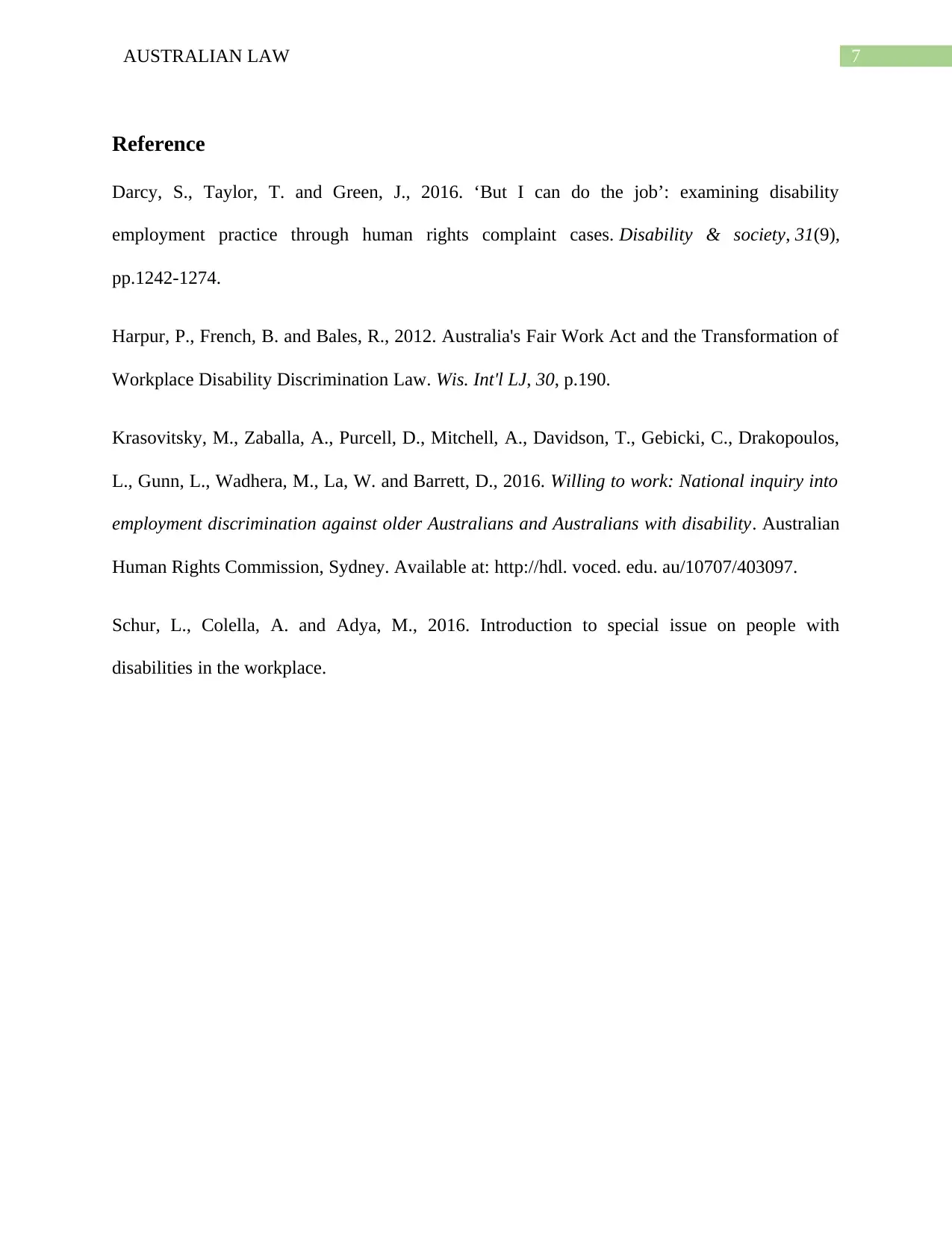
7AUSTRALIAN LAW
Reference
Darcy, S., Taylor, T. and Green, J., 2016. ‘But I can do the job’: examining disability
employment practice through human rights complaint cases. Disability & society, 31(9),
pp.1242-1274.
Harpur, P., French, B. and Bales, R., 2012. Australia's Fair Work Act and the Transformation of
Workplace Disability Discrimination Law. Wis. Int'l LJ, 30, p.190.
Krasovitsky, M., Zaballa, A., Purcell, D., Mitchell, A., Davidson, T., Gebicki, C., Drakopoulos,
L., Gunn, L., Wadhera, M., La, W. and Barrett, D., 2016. Willing to work: National inquiry into
employment discrimination against older Australians and Australians with disability. Australian
Human Rights Commission, Sydney. Available at: http://hdl. voced. edu. au/10707/403097.
Schur, L., Colella, A. and Adya, M., 2016. Introduction to special issue on people with
disabilities in the workplace.
Reference
Darcy, S., Taylor, T. and Green, J., 2016. ‘But I can do the job’: examining disability
employment practice through human rights complaint cases. Disability & society, 31(9),
pp.1242-1274.
Harpur, P., French, B. and Bales, R., 2012. Australia's Fair Work Act and the Transformation of
Workplace Disability Discrimination Law. Wis. Int'l LJ, 30, p.190.
Krasovitsky, M., Zaballa, A., Purcell, D., Mitchell, A., Davidson, T., Gebicki, C., Drakopoulos,
L., Gunn, L., Wadhera, M., La, W. and Barrett, D., 2016. Willing to work: National inquiry into
employment discrimination against older Australians and Australians with disability. Australian
Human Rights Commission, Sydney. Available at: http://hdl. voced. edu. au/10707/403097.
Schur, L., Colella, A. and Adya, M., 2016. Introduction to special issue on people with
disabilities in the workplace.
1 out of 8
Related Documents
Your All-in-One AI-Powered Toolkit for Academic Success.
+13062052269
info@desklib.com
Available 24*7 on WhatsApp / Email
![[object Object]](/_next/static/media/star-bottom.7253800d.svg)
Unlock your academic potential
Copyright © 2020–2025 A2Z Services. All Rights Reserved. Developed and managed by ZUCOL.





